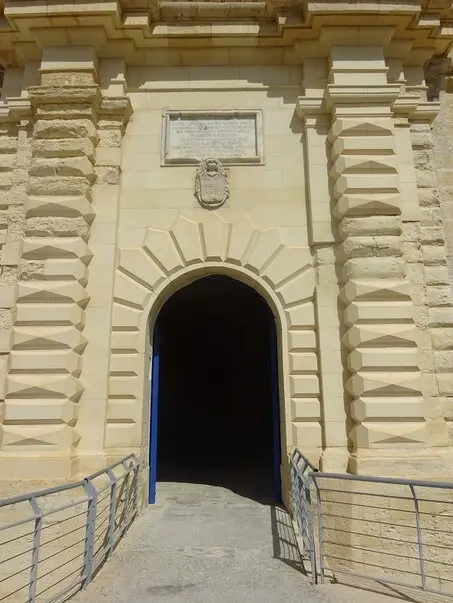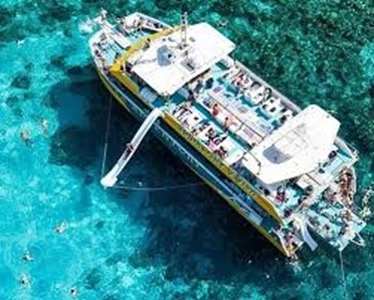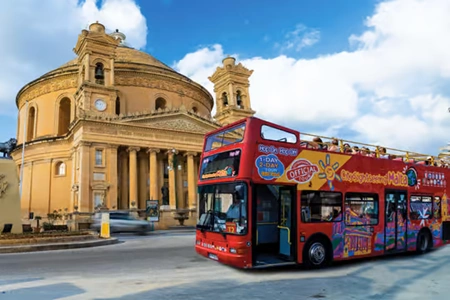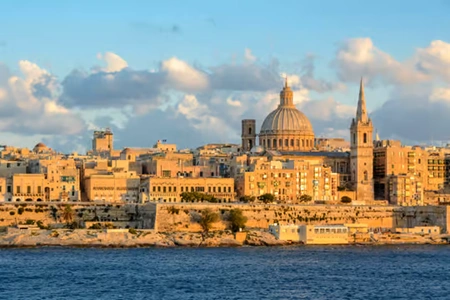Fort Saint Angelo
Phoenicians, Greeks, Romans, Byzantines, Arabs, Normans, the Angevines, the Aragonese and the Order of Saint John all contributed to the development of Birgu.
App info: In our app you will find the location, address, opening hours and admission / entrance fee of this spot. If you use the app, you will find additional information and news about this spot on this page.
Excavations have shown that from prehistoric times this location (Fort St. Angelo) has been a reinforced habitable area. The Temple of Astarte (3,200 - 600 BC) also stood here in the Bronze Age.
An Egyptian pink granite column and large ashlar blocks can still be found in the chapel of the Fort.
Castle Castrum Maris (castle by the sea) was probably built during the Arab occupation to protect the port area and its ships.
The castle consisted of an inner and outer department, a barbican (hidden outpost or passage) and four towers, one of which is in a D-shape. There were two chapels, one dedicated to St. Mary (current church of St. Anne) and one chapel dedicated to St. Angelo (later dedicated to the Birth of Our Lady). Part of this castle is integrated in the current fort.
From the time of Count Roger the Norman (1091), the castle was the residence of the feudal lords, who ruled Malta. The most famous Castellaan families that inhabited the castle were the Guevara and De Nava.
The mistress of Castellaan De Nava protested because she did not have the same status as the wife of Castellaan De Nava. Because Nava wanted to prevent his affair from becoming publicly known, he ordered two soldiers to send his mistress away.
The guards did not send her away but locked her up in the dungeon of the castle and then killed her. When De Nava heard this, he had the two soldiers killed. When opening a sealed room, the skeletons of the mistress and the two soldiers would have been found. No official documents can be found about this discovery.
The mistress now still roams around and is known as the Gray Lady. It is claimed that during the Second World War she would have saved soldiers from an air raid.
Documents show that in the period 1266-1283 the garrison consisted of 150 men and different weapons and that the castle already had two chapels in 1274. These chapels are still there.
When the Order of St. John came to Malta in 1530, Grandmaster L'Isle Adam settled in the castle and it became the Headquarters of the Order.
Subsequent Grandmasters continued to live in the castle until Jean de La Valette moved to a palace in Birgu.
It was the Order that each time reinforced the castle with the latest defence insights and made it an impregnable Fortress.
D'Homedes Bastion was built in 1536 to control the entrance of the Grand Harbour and part of the Marsamxett Harbour (near Fort Manoel). The dry ditch between the fort and Birgu (Vittoriosa) was also cut into a canal.
In 1547 a cavalier was built behind the D'Homedes Bastion and the Guirial Battery was built at sea level, named after commander Francesco de Guiral. The extensions were realized based on the design architect and military engineer Antonio Ferramolino. This addition also protected access to the Dockyard Creek.
Grandmaster Philippe Villiers de L'Isle-Adam (deceased in 1534), Piero de Ponte (deceased in 1535), Juan de Homedes y Coscon (deceased in 1553) and Claude de la Sengle (deceased in 1557) were buried in the chapel of St. Angelo. Their crypts were later moved to St. John's Co-cathedral.
In 1565 Malta was attacked by the Ottomans), this attack is known as "The Great Siege of Malta".
There are also ghosts of Ottoman soldiers who were executed during the Great Siege of 1565.
Perhaps the intervention in the period 1676 and 1690 was the most important and the largest intervention. Based on the plan of military engineer Carlos de Grunenburgh, parallel cannon batteries were built on four levels, with a view of the harbour.
This modification made the castle impregnable. The coat of arms of Grunenburgh, who also financially supported the modifications, is located above the main gate.
During the French occupation (1798-1800) the fort was fortified and had 80 guns, 48 of which were aimed at the entrance to the Grand Harbour.
The fort also became the headquarters of the French army.
The fort also retained its military function in the British period.
Two battalions were stationed around 1800.
In 1860 a battery was modified to a gun battery for three 9-inch RML guns.
In 1903 the fort was transferred to the Royal Navy. The Royal Navy got its base in the Mediterranean Sea and the fort became a stone frigate and was named HMS Egmont.
In 1933 the name was changed to the HMS St Angelo.
A cinema for the men was added to the Fort and a water distillation plant was also added.
On drawings from that period you can clearly see that the fort was built as a ship e.g. the kitchen was mentioned as galley. During the Second World War, 3 Bofors guns were placed in the fort.
The Fort was hit 69 times between 1940 and 1943.
Opening hours | Daily 10:00 - 18:00 |
Last admission | Advice 45 minutes before closing |
Closed | |
Ticket / admission fee | |
Adults (18+ yrs) | € 10.00 |
Youth (12- 17 yrs) | € 6,00 |
Children (6-11 yrs) | € 4.00 |
| Infants (1-5 yrs) | Free |
Seniors Citizen (60+ yrs) | € 2.00 |
Concessions and Students | € 6.00 |
Address and street / location can be found on our map, click on Guide in the menu bar and you will get a map with markers. | |
Book: Buy tickets for place of interest. sights, hop on hop off buses, exhibitions, safari, etc or book and tour. | |
Latest news and original website of the attraction / spot / advent | |
Additional information









